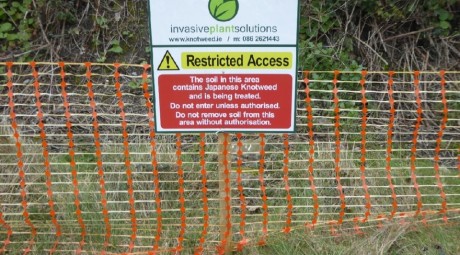JAPANESE KNOTWEED – PROPERTY DEAL BREAKER
November 16th, 2016

There are few words that strike fear in the hearts of property practitioners like these two – Japanese Knotweed – innocuous enough as the name may sound they have come to represent the ultimate home sellers nightmare. Who would ever have thought you could lose a sale based on an innocent looking plant in your garden?
Thankfully our recent experience recounted below is now over as of last week the 10th of November 2016.
We came into the unwanted terrain of dealing with a Japanese knotweed property quite unexpectedly. We were instructed by a client to deal with a property located in a prime gated development in North London on their behalf, all the initial due diligence had been carried out and we were well on our way to completing the deal when in the course of conversations it slipped from the management company that there was an issue with Japanese knotweed in the communal garden, the valuation report conducted earlier had not picked up this scourge.
These plants classified by the Environment Agency as the UK’s “most aggressive and destructive plant”, can grow beneath concrete and tarmac, causing damage to buildings, roads, driveways, and drains was introduced to Europe by German botanist Phillipp von Siebold in the 1800s were initially seen to be harmless judging by their characteristics in their original habitat in the Volcanic areas of Japan. However unhindered by such difficult climes, they grow unhindered in Britain.
The plants which evidence shows were still purposefully planted up till the late ’60s and early ’70s to fill in the gaps between train lines and homes cheaply and to form a barrier between both, went for quite some time with their potential threats unnoticed. They start growing in spring reaching 1.5m in May and 3m in June. They can grow up to 20 cm per day through concrete and tarmac with roots that go 3m deep damaging foundations.
These plants are notoriously difficult to deal with, as any fragments left behind can restart the entire growth process again. Indeed a couple chose to knock down and rebuild their home rather than try and treat the knotweed problem which saw the plant growing through their floors.
In this instance all parties needed to be notified, the bank was now reluctant to move forward and the buyer was having second thoughts. Immediate and urgent plans had to be set in place to deal with this problem, to ease the uncertainty both as to the properties long term viability and to the progression of the deal.
Despite assurances from the management Company that a contractor had been engaged to commence the treatment, control and eradicate the plant, progress was only made when the contractor assured guarantees will be issued after the treatment.
The buyer agreed to proceed only after obtaining a significant price reduction, a course of action that would have otherwise terminated the deal had there been no upper chain involved.
Despite the best efforts of all parties and the fact that the situation was effectively handled, the process was lengthened by an additional ten weeks.
One sobering lesson from this episode was the fact that an otherwise valuable asset could significantly diminish in value overnight for the most unobvious reasons.
Some takeaways from this are firstly if there is an episode of Japanese knotweed involved in a potential sale, flee the scene and don’t look back for any reason.
Homeowners should drop their laissez-faire approach and should be conscious of their surrounding as the plant in a neighbors house could still adversely impact on yours.
Lenders are scared to lend on homes with the issue as it is notoriously hard to deal with. Cutting it down doesn’t get rid of it either and it is hard to notice in winter.
Sadegh Shahsavari, a seasoned property expert sums it up like this. “The worst thing a survey can bring up isn’t asbestos or subsidence, it’s Japanese Knotweed. It’s more akin to cancer whilst the others are like a broken leg, easily fixable”. He goes on to say that No buyer wants to touch it and no lender wants to lend on it, with the immediate mentality being to run in the other direction.
The reason being that it doesn’t reduce the price, it makes it un-saleable.
However, if you’re not a property professional, don’t think you’re clever buying it at a discount. Albeit there are those out there who say they can treat it, its best left to the highest levels of expertise.
Mark Cohen, an experienced Surveyor with Cordell Marks says “contact a professional experienced in the handling of Japanese Knotweed as it requires skilled hands to deal with it, Even the droppings from already cut Japanese knotweed can lead to a resurgence and if any droppings get on a neighbors property, it is classed as an offense and you might be liable to pay damages”.
Obi Chianumba RICS Valuer of Newman Webb says “Treatment would get rid of it mostly but regular visits are conducted by the agency dealing with it over a two to three year period to ensure the problem is well and truly dealt with”.
HOW TO SPOT KNOTWEED ON YOUR POTENTIAL PROPERTY
Spring: Purple shoots emerge from the ground, eventually forming thick canes.
Summer: The canes develop purple flecks. By late summer they sprout spiky clusters of off-white flowers.
Winter: The flowers die off leaving dead, hollow brown bamboo-like canes standing often as tall as three meters.
Japanese Knotweed is becoming more prevalent in Britain and is treatable, but its a nightmare you want to stay well clear from.

Leave a Reply